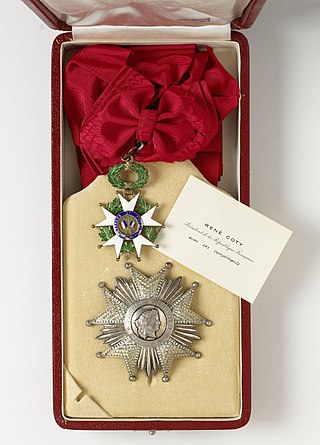
The National Order of the Legion of Honour, formerly the Imperial Order of the Legion of Honour, is the highest French order of merit, both military and civil, and currently comprises five classes. Established in 1802 by Napoleon Bonaparte, it has been retained by all later French governments and regimes.

The Most Excellent Order of the British Empire is a British order of chivalry, rewarding contributions to the arts and sciences, work with charitable and welfare organisations, and public service outside the civil service. It comprises five classes of awards across both civil and military divisions, the most senior two of which make the recipient either a knight if male or a dame if female. There is also the related British Empire Medal, whose recipients are affiliated with, but not members of, the order.

The Order of Leopold is one of the three current Belgian national honorary orders of knighthood. It is the oldest and highest order of Belgium and is named in honour of its founder, King Leopold I. It consists of a military, a maritime and a civil division. The maritime division is only awarded to personnel of the merchant navy, and the military division to military personnel. The decoration was established on 11 July 1832 and is awarded by Royal decree.
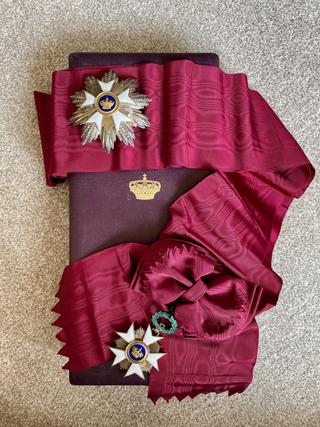
The Order of the Crown is a national order of the Kingdom of Belgium. The Order is one of Belgium's highest honors.

The Order of Orange-Nassau is a civil and military Dutch order of chivalry founded on 4 April 1892 by the queen regent, Emma of the Netherlands.
Authorized foreign decorations of the United States military are those military decorations which have been approved for wear by members of the United States armed forces but whose awarding authority is the government of a country other than the United States.

The Order of Civil and Military Merit of Adolph of Nassau is an order of merit of the Grand Duchy of Luxembourg for meritorious service to the Grand Duke, the Grand-Ducal House and Luxembourg. It was founded in 1858 as a chivalric order of the Duchy of Nassau by Adolphe of Nassau in honor of his namesake and ancestor, Adolf, Count of Nassau, the only member of the House of Nassau to have been Roman King of Germany. After the Duchy of Nassau was annexed by Prussia in 1866 and Adolphe became Grand Duke of Luxembourg in 1890, he revived the order as an order of merit.

The Ancient and Most Noble Military Order of the Tower and of the Sword, of the Valour, Loyalty and Merit, before 1910 Royal Military Order of the Tower and Sword, is a Portuguese order of knighthood and the pinnacle of the Portuguese honours system. It was created by King Afonso V in 1459. The order may be bestowed on people or on Portuguese municipalities.

This is a list of Norwegian orders and medals, in order of precedence. This list contains all medals approved for wearing on a Norwegian military uniform in ranked order.
The Order of the African Star was established by Leopold II of Belgium on 30 December 1888, in his capacity as ruler of the Congo Free State, and was awarded for services to Congo and for the "promotion of African civilisation in general". It was incorporated into the Belgian honours system on 10 October 1908 following the annexation of the Congo Free State by Belgium. The motto of the Order is "Travail et progrès". The King of the Belgians is its Grand Master; although the Congo is no longer a Belgian colony, it is still considered to be a Belgian Order by tradition.
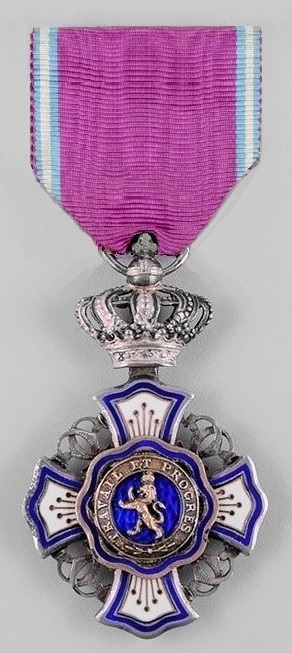
The Royal Order of the Lion was established by King Leopold II of Belgium on 9 April 1891, in his capacity as ruler of the Congo Free State, and was awarded for services to the Congo and its ruler that did not deserve the award of the Order of the African Star, and were not necessarily performed from within Belgian Congo.
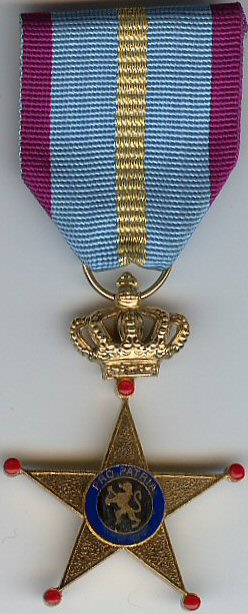
The Cross of Honour for Military Service Abroad is a Belgian military decoration originally established for award to Belgian servicemen who served for a long period of time in the Federal Republic of Germany, Zaire, Rwanda or Burundi. It was established on 16 June 1997 in three classes.
Colombian military decorations date back as far as the founding of the country. An early decoration was the Cruz de Boyacá that was awarded to the generals who led their forces to victory in the Battle of Boyacá in 1819. This early decoration lives on today as an incarnation of the highest order presented by the Colombian state. There is one decoration higher, but it is only awarded for military conflicts in defence of Colombia. Other than military decorations, Colombia presents decorations on behalf of the National Government, decorations for the National Police, and decorations from the Congress of Colombia.

The Meritorious service medal for personnel of the Belgian Defence Forces and Foreign Armed Forces is a military decoration of Belgium. It was established on 23 February 2005 as a more rewarding successor of an earlier Medal of Military Merit and is awarded to members of the Belgian Armed Forces and civilians working for the Belgian Defence who show an exemplary meritorious behaviour in the completion of their duties or who have accomplished an exemplary meritorious act.
The Civic Decoration is a civilian decoration of the Kingdom of Belgium. It was first established by royal decree on 21 July 1867 to reward exceptional acts of bravery, devotion or humanity. A further royal decree of 15 January 1885 extended the award to state civil servants for long service by a mere change of ribbon. The award statute was once again amended by royal decree in 1902 to include long service in the Civic Guard and firefighters, each with its distinctive ribbon.

The Military Decoration is a military award of the Kingdom of Belgium. It was established on December 23, 1873 and is awarded to non-commissioned officers and other ranks of the Belgian Armed Forces for long service. Initially, the medal was created in 2 versions. The version for exceptional service, gallantry or devotion to duty was created by the same royal decree, has the same jewel, but a different ribbon. Currently, both medals still exist, but are considered to be separate awards, not variations of the same award.
The Croix de guerre (French) or Oorlogskruis (Dutch) is a military decoration of the Kingdom of Belgium established by royal decree on 25 October 1915. It was primarily awarded for bravery or other military virtue on the battlefield. The award was reestablished on 20 July 1940 by the Belgian government in exile for recognition of bravery and military virtue during World War II. The post-1940 decoration could also be awarded to units that were cited. The decoration was again reestablished by royal decree on 3 April 1954 for award during future conflicts.
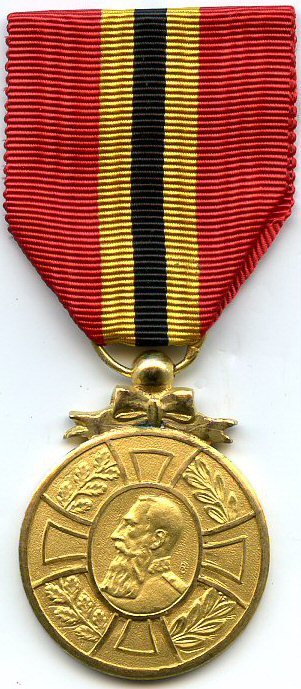
The Commemorative Medal of the Reign of King Leopold II was a Belgian civilian and later military and police forces medal originally established on 21 July 1905 by royal decree to commemorate the 40th year of the reign of King Leopold II.
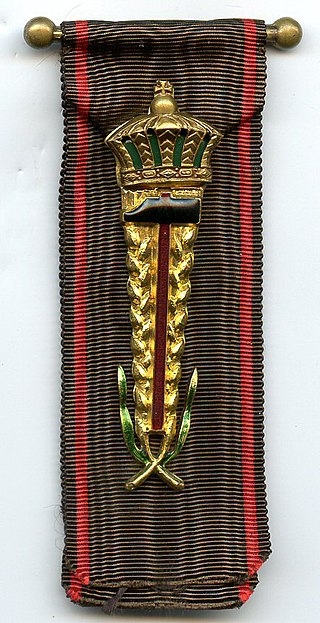
The Honour Badge of Labour is a Belgian award aiming at rewarding especially meritorious workers for their skills and commitment to their profession. It is awarded by Royal Decree on a proposal from the Royal Institute of the Elites of Labour. The award was officially created in 1948 on the basis of earlier badges awarded to meritorious workers during labour fairs as early as 1847.

The Commemorative Decoration of the 50th Anniversary of the Creation of the Railroads 1834-1884 was a Belgian commemorative award denoting the 50th anniversary of the law of 1 May 1834 ordering the creation of railroads in Belgium. It was established by royal decree of King Leopold II on 30 April 1884 at the suggestion of the ministers of Public Works and of the Interior, its statute was ratified by a further royal decree on 11 July 1884.

















